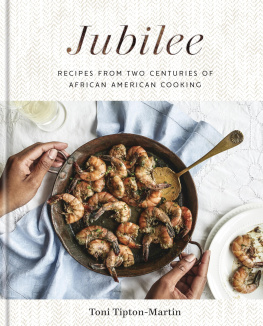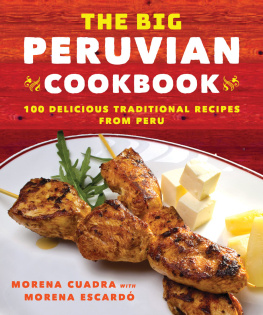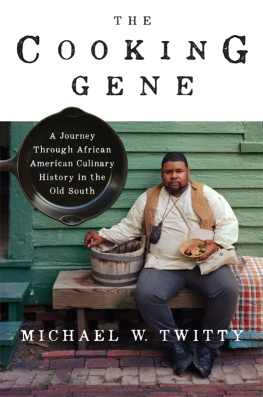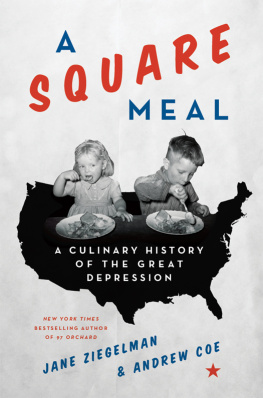
PAT WILLARD

For my sons, Sam and Al
Contents
The America Eats! papers reprinted in this book have not been altered in any way. All idiosyncrasies in spelling, grammar, punctuation, and dialectexcept for where there are obvious typing mistakes in the originalalong with racial and social attitudes expressed in the original papers remain intact as a reflection of 1930s America.
* 1 *
The American Cauldron
If each of all the races which have been subsisted in the vast Middle West could contribute one dish to one great midwestern cauldron, it is certain that wed have therein a most foreign and most gigantic stew: the grains that the French took over from the Indians, and the breads that the English brought later, hotly spiced Italian dishes and subtly seasoned Spanish ones, the sweet Swedish soups and the sour Polish ones, and all the Old World arts brought to the preparing of American beefsteak and hot mince pie.
Such a cauldron would contain more than many foods: it would be at once, a symbol of many lands and a melting pot for many people.
Many peoples, yet one people; many lands, one land.
Nelson Algren, Illinois Office
Americas culinary history is enough to make anyone scream. By which I mean the accepted line of thinking held mostly by the folks who write about food and who reside in the populated cities along our coastlines. You know the line I mean, the great lament concerning our national cuisine and the poverty of its heritage. It is not a pretty tale they tell at all. I have a feeling that at the heart of these hard appraisals lies a self-conscious regret that the food we think of as truly Americanthink pies and barbecues, thick stews, a good roasted chicken, a tender slab of steakdid not romantically develop over hundreds of years from the rustic charms of peasant fare through to the haughty demands of imperial refinements. Instead, our cuisine, like much of American life, developed on the fly, in a rush from one place to another, in a great confluence of necessities, contrasting agendas, and, most important, unprecedentedly varied cultural influences. Our dishes were bound by the imperative to survive. The strange things that were discovered growing along the way, tramping in the woods, or swimming in the streams could perhaps be made tasty, or at the very least palatable, with the addition of some dried herbs and spices, which by forethought or fortune had been tucked in a calico pocket or leather pouch for the long journey out from a distant home to this unfamiliar new land where another, possibly better, life could be made.
What else but a mess could develop in such a haphazard fashion? And a mess is what many have taken American food to be when compared to the glories of other countries cuisines. Let me just clarify that I am not excusing the corporate adulteration of our national food supply and the resulting mess this has engendered to our health and palate. Nor am I forgetting any of our truly lamebrained cooking stumbles (white sauceand its horrid sister, French dressingas an accompaniment to everything; the entire health craze of the 1870s; and anything with potato chips or canned fruit in the recipe, to name some of my favorites). Instead, what I am trying to untangle from these knots are the roots of American cooking and the unique traditions that went along with sitting down at a table among our fellow countrymen.
The bad press that our national cuisine has received at times is partly due to timing. You cant tell me every other country in the world has not had its share of bad kitchen days. But, in comparison to others, ours is a decidedly young cuisine. Think about itcompared to our four hundred years of cooking, nearly every cuisine that is considered great has been developing for at least a thousand years. On top of this, our cooking has had the misfortune to develop just when mass media was beginning to flourish, which subsequently allowed our most egregious sins to be so widely broadcast. Yet, in its continuing development over the last few decades, a new reverence for some of our culinary treasures has taken hold. This, in turn, has spurred the increasing growth of fresh, well-grown fruits, vegetables, grains, and meats that are now being offered in most marketsfrom high-price chichi organic outposts to inner-city chain groceries. Greenmarkets chock full of local farm produce now take over many city streets and town squares, and a long overdue scrutiny of our food supply is increasingly being demanded. And yet, despite all this, there remains a stubborn conviction about the history of American cooking that it amounts to nothing more than a lowly inheritance of indigestible sauces, unhealthy lard-laced dough, and everything fried in killer fats to a flirtatiously golden fare-thee-well.

Forks and spoons laid out for the Junior Chamber of Commerce buffet, Eufaula, Oklahoma, February 1940. (Russell Lee)
Thank God, then, for America Eats!, the manuscript written for the Works Progress Administration (WPA) by out-of-work writers during the Great Depression. The WPA, which grew out of the 1934 Civil Works Emergency Relief Act, employed nearly 9 million people who completed more than a million projects across the country, including the construction of roads, bridges, parks, and public buildings. Several art-related programs for the relief of writers, artists, and theater professionals were also set up. The Federal Writers Project, alone, involved thousands of laid-off reporters, fledgling novelists and poets (some of whom would go on to greatness), country librarians, housewives, and recent college graduates. After a somewhat lengthy, and what many considered to be a personally invasive, financial screening process to certify they were poor enough, the writers employed by the project were paiddepending on the cost of living in their state or cityanywhere from $50 to $103 a week. For this, they produced such works as histories of local institutions and communities, nature guides, and, most famously, state travelogues and oral histories of former slaves and general laborersfrom stonecutters to circus dancers.
In the later years of the program, one more assignment was added to the docket: writers, sometimes with photographers from the Federal Artists Project in tow, were asked to find out how America ate. Specifically, they were told to produce an account of group eating as an important American social institution; its part in development of American cookery as an authentic art and in the preservation of that art in the face of mass production of foodstuff and partly cooked foods and introduction of numerous technological devices that lessen labor of preparation but lower quality of the product. It was to be called America Eats! that final exclamation point a critical cue for the exuberance the subject was intended to arouse.
It was not to be a cookbookthe editor and chief motivator behind the book, Katharine Amend Kellock, was adamant about this point. In fact, she forbade any former cookbook writers or cooking teachers from submitting material for the book. What she envisioned, instead, were stories about local events where food was to be served: political, church, and community fund-raisers; religious revivals; possum dinners at Elks Lodges; ladies tea socials; family reunions; rodeos; state fairs; harvest festivals; cemetery-cleaning parties; and hobo encampments. The great theme of
Next page








